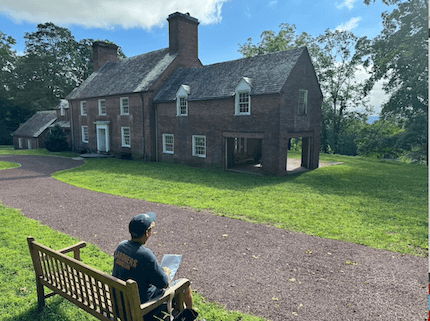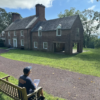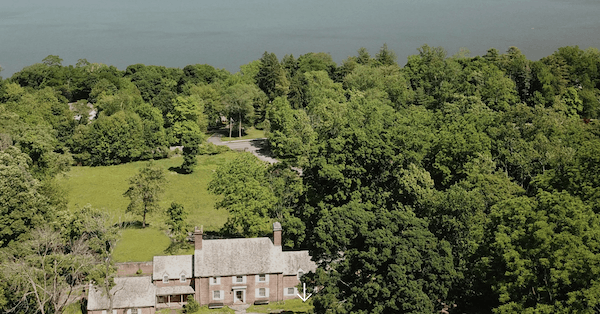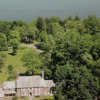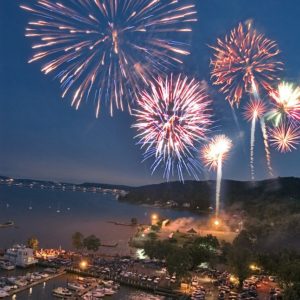Barons of Broadway #23
Unlike most Gilded Age mansion owners on North Broadway, Justin DuPratt White was a locally born, self-made man. Standing just over five and a half feet tall, White was hard-working and modest, known for his meticulous appearance. He favored conservative, neatly tailored suits and often adorned his lapel with a freshly cut flower.
The family’s mansion, Miramare, remains standing today as the main administration building at the Summit School, across from Upper Nyack Elementary School at 339 North Broadway. Remarkably, the original estate house, built around 1900, was entirely rebuilt in the late 1920s.

Beyond his striking home, White left a lasting legacy as a successful leader and philanthropist. He co-founded a global Wall Street law firm and helped establish numerous local organizations, including the Palisades Interstate Park Commission. A pioneering environmentalist, White played a significant role in shaping the verdant, park-filled landscape of Rockland County.
Early Life and Education
Justin DuPratt White, known throughout his life as DuPratt White, was born on July 25, 1869, in Middletown, Orange County, New York. He was the third of four children of Charles and Elizabeth White. His father worked as a railroad paymaster. By 1880, the family had moved to Passaic, NJ, where his father worked as a merchant. Later they moved to Suffern, NY, where White attended private school. When the family settled in Nyack, White attended Nyack High School. He graduated in 1885 as part of the first graduating class to receive state diplomas.


An academic standout, White earned a state scholarship to Cornell University, where he graduated in 1890. He edited the Cornell Daily Sun, participated in debating societies, and was a member of Alpha Tau Omega. After college, White apprenticed in law offices in lower Manhattan. He was admitted to the bar in 1892.
Founding White & Case

In 1894, after losing a local judicial election in Rockland County, White pivoted fully into law. With encouragement from friend Henry P. Davison of J.P. Morgan & Co., he formed a partnership with state senator Henry Coggeshall. In 1901, White co-founded White & Case with George B. Case, who, among other things, invented baseball’s “squeeze play” while attending Yale. Initially, the company occupied a two-room office on Nassau Street. Later, the firm expanded into the newly built 41-story Bankers Trust Company Building at 14 Wall Street. White was active in several prominent cases and held board positions in financial institutions like the Farmers Trust Company and Liberty National Bank.
During World War I, White & Case was hired by J.P. Morgan & Co. to help Great Britain and France purchase U.S. war supplies. Because of his efforts, White earned the title of Chevalier of the French Legion of Honor. The firm continued to expand internationally, opening its first non-U.S. office in Paris in 1926. It remains one of the world’s largest law firms.

White became the first White & Case partner to present a case to the U.S. Supreme Court when, in 1934, he represented New York Trust Company.. Not only did White achieve this first on behalf of the Firm, but he also won. He was also independent-minded and forthright, speaking out, for instance, against the Eighteenth Amendment and Prohibition.
White’s Commute & Social Life in Nyack
White commuted to the city on the Nyack Flyer that went express after the Sparkill stop. The flyer had business-class service in a special Pullman car. White often drove his convertible with the top down, winter or summer, down a few stops before getting on the train. While it seems White worked 24/7, he did have time for fun. As a member of the Nyack Country Club at age 22, White participated in an event known as “tennis extraordinary.” For the event, 6 men played tennis in drag. White dressed as a Grecian girl.

The Creation of Miramare
In 1898, DuPratt White married Anita Bradley Lombard, the daughter of a mining engineer from Georgia. Shortly after their marriage, White purchased a 10-acre property along the Hudson River, formerly part of the Hugh Maxwell estate. Across the street from this property stood Maxwell’s three-story brick house, which served as the clubhouse for the Nyack Country Club. The Whites had one child, also named Anita.

Construction on their new home began in 1903. The estate, named Miramare—Italian for “to gaze at the sea”—paid homage to Anita’s Italian heritage and referenced the renowned Miramare estate in Trieste, Italy. Built by local contractors M.H. & D. DeBaun for $19,000, the 14-room Tudor Revival-style house sat 90 feet below the grade of North Broadway. Other nearby properties, such as the Van Wyck Rossiter house on Midland (now the Nyack Field Club), Glen Iris, and the Moorings Cottages, also showcased Tudor designs.
While the front lawn remained heavily wooded, the east, or river-facing side, was cleared to offer stunning views of the Hudson River. Mrs. White meticulously landscaped the property, incorporating two old quarries into a walkway and adding a spring-fed swimming pool called “The Glen.” A low stone wall fronted North Broadway, stretching from the Old Stone Meeting House to Castle Heights Avenue. Linden trees planted between the wall and the road created a distinctive frontage, though their controversial removal in 2018 sparked local outcry. Over time, the estate expanded to include a stable, greenhouse, caretaker’s quarters, and other Tudor-style outbuildings.

Despite its beauty, photos of the house from 1925 depict a somewhat somber, ivy-covered structure. The design did not align with Anita’s tastes, and DuPratt White sought a larger home with a more substantial library.
Miramare 2.0

In the mid-1920s, White hired his Cornell classmate, the noted architect Frederick L. Ackerman, to renovate and expand the house. However, renovation proved impractical, leading to the old house’s demolition and the construction of a new, larger one on the same site. Ackerman incorporated stone quarried near Cornell University at White’s request and designed the new house with an irregular layout that enhanced its Tudor aesthetic. The original semicircular retaining wall in front of the entrance was preserved and adorned with rhododendrons. Custom-designed stained-glass windows further accentuated the enlarged and redesigned porte cochere.








Several views of Miramare’s exterior and interior circa 1930.
Inside, Ackerman designed the main staircase to remain hidden, promoting a smoother flow between the rooms on the first floor. The library became a particularly unique feature, with three alcoves fitted for books. Due to the property’s grade, the alcove sills were six feet above the floor, providing seating areas with bookshelves that offered views of the grounds and the river from windows across the room. Mrs. White enhanced the home by installing an Aeolian pipe organ, which Anita played during gatherings of the Nyack Morning Music Club. The property also extended to include strips of land along Perry Lane and Broadway, reaching Castle Heights Avenue.




Architectural plans for Miramare.
The House That Ackerman Built
By 1929, the new estate was complete. In 1930, it housed DuPratt White, Anita, White’s sister, and seven servants. Valued at $750,000 at the time (equivalent to approximately $14 million today), Miramare stood as a testament to the Whites’ vision and Ackerman’s architectural expertise.
Community and Environmental Leadership
White was a founding member of the Palisades Interstate Park Commission (PIPC), eventually serving as its chairman for many years. His vision secured funding and land for future parks, including Bear Mountain and the local Hook Mountain and Nyack Beach State Parks. Working for thirty-nine years with donors like J.P. Morgan and the Rockefeller family, he ensured that land around Nyack would remain undeveloped, preserving its natural beauty for future generations.

One of his notable achievements was negotiating a donation of 700 acres from John D. Rockefeller for the future creation of the Palisades Interstate Parkway. White was committed to nature preservation, opposing overdevelopment that threatened parklands. His efforts ensured that Depression-era programs also benefited the park, with enduring structures still enjoyed today.

A Leader at Cornell University
White’s lifelong commitment to Cornell University extended far beyond his student days. As a trustee and chair of various committees, he helped raise $6 million for the university and played a significant role in its administration. In 1939, just before his death, he became Chairman of the University Board, leaving a lasting legacy at his alma mater.

End of an Era
Justin DuPratt White passed away on July 14, 1939, after a series of strokes. His funeral, attended by many from law, education, and government, underscored his far-reaching influence. Some seventy Palisades Interstate Park Commission policemen lined the Grace Church walkway as his casket was borne to a funeral coach. He was buried in Oak Hill Cemetery, along with his parents, leaving behind a legacy of service to his community and beyond.

White’s wife, Anita, lived at Miramare briefly after his death before selling the property to the Nyack Junior School in 1941. The school later became the Nyack Boys School. In 1972, Miramare was acquired by the Summit School, where it remains a part of Nyack’s architectural and cultural landscape.
A Lasting Legacy
While there may be no grand memorial to White among the 1,400 acres of preserved parkland at Hook Mountain, Nyack Beach, and Tallman Mountain State Parks, his impact on the region is undeniable. These “green bookends” around Nyack, with Miramare at the center, remain a testament to White’s vision for a landscape where nature and community coexist. His modest life and commitment to preserving the natural world are deeply woven into Nyack’s history—a legacy that endures for all to appreciate.
Barons of Broadway Series
#1 The Magnificent Saga Of Larchdell
#2 Revisiting Underclyffe–A Lost, Gilded Age Mansion
#3 The Adriance Era At Underclyffe Manor
#4 The Flying Dutchman Lands at Underclyffe Manor
#5 The Saga of Rivercliff’s Storied Residents
#6 The Winding Saga of River Hook
#8 The Legacy of Belle Crest: From Clockmakers to Tennis Champions
#11 The Dynamite Baron- Wilson P. Foss Legacy at Under Elms
#12 Atlas Acres – The Botanist in Under Elms’ Garage
#13 The Baroness of Shadowcliff
#14 The Peace Room at Shadowcliff – The Story of the Fellowship of Reconciliation
#15 The Troubled Legacy of Williamson Manor
#16 The Moorings: A Confederate General & the Cottages
#17 The Moorings: A Glimpse into the Clarkstown Country Club Era
#18 The Legacy of Henry Palmer – Nyacks First Baron of Broadway
#19 Glenholme: A Historic Estate’s Evolution & Enduring Charm
#20 From Humble Beginnings to Glen Iris: The Rise of Judge Tompkins
#21 Nyack’s Last Riverside Colonial Cottage – The Home of Major John Smith
#22 Wilson Defendorf–Nyack’s Real Estate Baron & Civil War Captain
Mike Hays lived in the Nyacks for 38-years. He worked for McGraw-Hill Education in New York City for many years. Hays serves as President of the Historical Society of the Nyacks, and Vice-President of the Edward Hopper House Museum & Study Center. Married to Bernie Richey, he enjoys cycling and winters in Florida. You can follow him on Instagram as UpperNyackMike.
Editor’s note: This article is sponsored by Sun River Health and Ellis Sotheby’s International Realty. Sun River Health is a network of 43 Federally Qualified Health Centers (FQHCs) providing primary, dental, pediatric, OB-GYN, and behavioral health care to over 245,000 patients annually. Ellis Sotheby’s International Realty is the lower Hudson Valley’s Leader in Luxury. Located in the charming Hudson River village of Nyack, approximately 22 miles from New York City. Our agents are passionate about listing and selling extraordinary properties in the Lower Hudson Valley, including Rockland and Orange Counties, New York.




